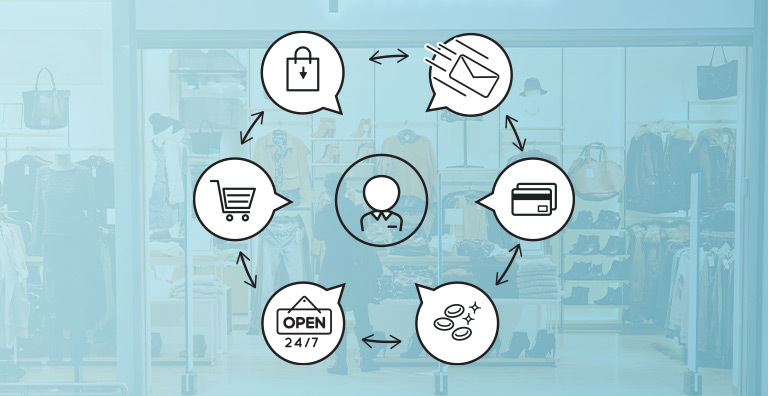Over the past few years, retail experts have predicted the rise of omnichannel retail. As customers become increasingly comfortable online, it only makes sense that shopping habits would begin to shift seamlessly between on and offline options. But the shift was occurring gradually. Then came 2020, with its lockdowns and social distancing. Almost overnight, omnichannel went from a nice-to-have to a must-have for most retailers.
Pre-pandemic, 9 percent of consumers were regularly mixing online and in-person shopping. A year later, that number has jumped dramatically with 44 percent of consumers regularly utilizing e-commerce options. Looking ahead, 40 percent of shoppers say they expect to continue their online shopping habits after the pandemic ends.
However, consumers aren’t choosing online over brick-and-mortar. When given a choice, 46 percent opt for in-person shopping over e-commerce. But no matter the preference, customers want a seamlessly integrated experience that makes it easy to move from online to in-person shopping and back again. Here’s a look at what an omnichannel experience means to today’s shoppers and how to meet their expectations.
What is omnichannel retail?
As shopping behaviors evolve, so does the definition of omnichannel retail. A retailer has a multi-channel strategy when it provides brick-and-mortar, web, and mobile shopping experiences. The strategy becomes omnichannel when the retailer stops treating the options as separate channels and starts viewing them as their customers do – a single integrated experience that allows customers to easily transition from one channel to another and even use them simultaneously, such as looking at customer reviews on their smartphone while shopping in-store.
The simplest definition of omnichannel retail is when all channels – brick-and-mortar, e-commerce, and social media – work together to meet customers wherever they are to influence a sale and strengthen the overall relationship. Having an omnichannel experience pays off. Omnichannel customers spend an estimated 35 percent more per transaction and have a 30 percent higher customer lifetime value.
3 essentials for delivering on omnichannel
So, how do you eliminate barriers between channels and bring your physical and digital shopping experiences together? Start with these three essential elements.
1. Integrated point-of-sale
Nothing will be seamless until you have a fully integrated point-of-sale (POS) system. Your POS should function as your business’s omnichannel engine that combines data from brick-and-mortar and e-commerce to create an experience that recognizes the customer’s purchase history and preferences, no matter how they decide to shop.
Profiles and personalization
Along with capturing customer profile data, your POS should make the information easy to access and apply to in-person experiences, digital interactions, and ongoing marketing. In other words, the in-store sales team should be able to see a customer’s profile and make personalized recommendations based on past purchases, style preferences, or loyalty program levels. The same type of profile data should feed online shopping to make “you may also like” suggestions and alert shoppers to loyalty program milestones or discounts. And finally, the same data – captured and integrated across channels – can guide targeted marketing outreach and promotions. Attention to data detail is worth it. Customers are 110 percent more likely to buy additional items and 40 percent more likely to spend more than they planned when shopping experiences are personalized.
Check-out ease
Whether they’re standing in front of you or purchasing online, customers expect the check-out experience to be simple and quick. One way to ensure ease is by accepting a range of payment options. Look for a POS system that gives you the flexibility to accept everything from cash, credit, and debit cards through gift cards and contactless payment options, such as Apple Pay and Google Pay. If you aren’t able to accept a customer’s preferred payment option, more than half will walk away from the purchase. Plus, even if they complete the transaction, they’re likely to choose to shop elsewhere the next time.
Related: How to Improve Customer Experience Using POS Data
2. Integrated inventory and reporting
Delivering an omnichannel experience requires omnichannel inventory management capabilities. Your POS system should provide you with an integrated, real-time view of the physical stock that’s in your warehouse, what’s sold, both in-store and online, and what’s been ordered. Your POS should also be your one-stop resource for ordering, tracking, analyzing, and adjusting inventory across channels.
Integrated inventory management facilitates omnichannel customer experiences, especially when a customer begins by browsing online and finishes with an in-person purchase. If your website tells the customer the item they’re looking for is available, that means they’ll expect it to be available whether they purchase online or stop by the store. Look for a POS system that provides up-to-the-minute inventory tracking and reporting views for both you and your customers.
In addition, leverage your POS system’s capabilities like automated reporting and re-order triggers across channels to ensure you keep the right amount of stock on hand.
Related: Omnichannel Inventory: Avoid These 3 Obstacles
3. Integrated end-to-end experience
Meeting your customers wherever they are – online, mobile, or in-store – takes a holistic approach to customer experience. Your sales channels have to work together with your marketing engagement strategies to imagine and fulfill customer expectations. Here are a few examples of integrated experiences:
Curbside convenience
A customer can shop and purchase online but choose to pick up their items in-store or curbside. The popularity of this convenient option took off during the COVID-19 pandemic and shows no signs of slowing down. Integrated inventory management and robust e-commerce capabilities make it possible – and relatively simple – to offer customers this option.
Loyalty boosts
Today’s loyalty programs do more than deliver savings to participating customers. They strategically inspire repeat purchases and loyalty through tiered levels of achievement and insider perks like previews and exclusive events. By integrating your rewards program with your POS, it’s easy to alert customers at check-out when they’re nearing a milestone or create and host events.
Enhanced mobility
The amount of time people spend using their mobile devices continues to increase. For a seamless shopping experience, make enhanced mobile capabilities a priority. That means ensuring your online shopping experience is optimized for mobile and that your POS enables contactless payments using a digital wallet. It also means enabling mobile POS within your brick-and-mortar store so that your sales team has tablet access to complete inventory lookups and process payments from anywhere in the store.
Related: The Top POS System Trends for 2021
POSIM is a point-of-sale and inventory management system designed to help you optimize omnichannel experiences from integrated inventory and reporting through e-commerce and check-out ease. Discover what’s possible with POSIM. Contact us for a demo today.












